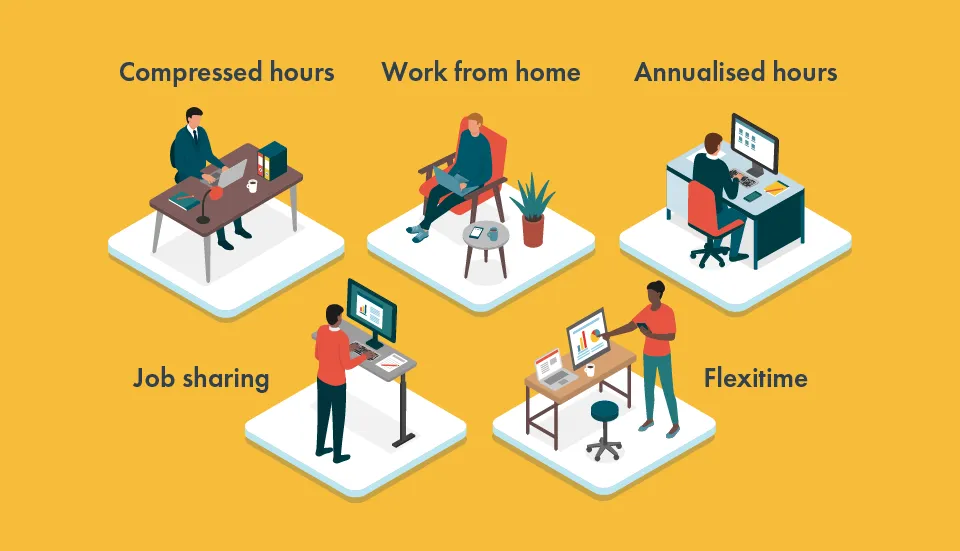How to deal with flexible working requests (plus free flexible working request letter template)

In the last few years, flexible working has become much more common and expected, and businesses large and small need to know how they want to meet this growing demand.
Small businesses that don’t offer flexible working, or don’t have a clear flexible working policy in place, are very likely to receive a flexible working application sooner or later. Earlier this year, for example, an ONS study revealed that almost as many people now work from home, or work part of the week from home, as commute to the office.
As one of Charlie’s CIPD-qualified advisors, I help new and small businesses understand and comply with HR law requirements — including, how to deal with increasing numbers of flexible working requests.
So I’ve put together this guide to help employers navigate the world of flexible working. It covers an up-to-date overview of employees’ rights (the law has changed very recently), and includes advice on how you, the employer, should respond to their flexible working requests.
And to make things easier, I’ve also included a free flexible working request letter template that your employees can start using straight away. Download it now, or at the end of the article.

Please note: flexible working rules are different in Northern Ireland.
What is flexible working?
Flexible working is described by GOV.UK as “a way of working that suits an employee’s needs, for example having flexible start and finish times, or working from home”. And there are various different ways people can work flexibly.
Flexitime (a working schedule with set core hours and flexible start and finish times), compressing working hours, or reducing the number of total hours (moving to part-time) are all examples of flexible working.
As an employer, promoting flexible working is a way of attracting and retaining talented employees.
What is a flexible working request?
A flexible working request, also known as ‘making a statutory application’, is when an employee asks their employer if they can change the hours they work, the times they work, or their working location.
Any employee has the right to request flexible working, and an employer must consider each individual flexible working request in a ‘reasonable manner’ (more on this below under What is the law around flexible working?).
The request must be in writing, and should clearly communicate the type of flexible working that’s being requested. For example:
- working from home
- working the same number of hours across fewer days (compressed hours)
- working core hours, but varying the start and finish time (flexitime)
- job sharing - where two people do one job and divide the hours between them
- working a set number of hours across the year, rather than the same number of hours every week (annualised hours)

Flexible working request reasons
There are many reasons why someone in your team might put in a request to work more flexibly. Some of the most common flexible working request reasons are:
- To achieve a better work-life balance: working more flexibly can help people to better accommodate their commitments and interests outside of work — which can positively impact their mental health.
- Because of caring responsibilities: working parents and carers often require more flexibility, especially at the start and end of the day. Changing their hours to reflect this will make things easier for them and relieve stress (about not making it into work ‘on time’, for example).
- To improve productivity: people are more or less productive at different times of day, and this varies from person to person. Some of your team may feel they get more done earlier in the day, while others may feel the complete opposite. Early champions of flexible working have reported increases in productivity as a result of accommodating their employees’ individual working preferences.
- To retain people: since Covid, many people see flexible working as a requirement rather than a perk. If you don’t offer flexible ways of working at your business, then some of your best people could start looking for opportunities elsewhere.
- To promote diversity: flexible working and diversity go hand-in-hand. You can’t expect to attract employees from different backgrounds, and with different experiences, if you only offer a ‘one size fits all’ style of working. Changing the way people can do their jobs will open the door to a much broader group of applicants.
- For personal reasons: a flexible working request doesn’t have to include the reasons why an employee wants to work more flexibly. As long as they still fulfil the requirements of their role, they don’t actually have to tell you why.
What is the law around flexible working?
With the new flexible working law coming into effect on on 6 April 2024, team members can request flexible working arrangements from their first day on the job. (Previously, this right was available only to employees who had worked for the same employer for 26 weeks or more.)
In July 2023, the Flexible Working Rights & The Employment Relations (Flexible Working) Act 2023 received the Royal Assent, bringing in some important changes in the law around flexible working.
- Employees can now make two flexible working requests within a 12-month period.
- Employers have to deal with flexible working requests within two (rather than three) months, unless there is an agreed extension by both parties. This is to ensure that employees receive a timely response, and are not left in limbo waiting to hear if their request has been accepted or rejected.
- Employers can no longer refuse a flexible working request without having first “consulted” with the employee.
- Employees no longer have to explain how their flexible working request may impact their employer or propose how any potential issues could be addressed. This is to reduce the burden on employees when submitting flexible working requests, and to put more responsibility on the employer.
As per the previous flexible working laws, employers must deal with all flexible working requests in a ‘reasonable manner’. This means that employers should:
- set up a meeting to talk through the request with the employee
- assess both the advantages and disadvantages of the request
- have an appeal process in place
An employee can take their employer to an employment tribunal if they feel their request has not been dealt with in a reasonable manner.
If a flexible working request is agreed, the employer must update the terms and conditions in the employee’s contract.
If the request is rejected, the employer must write to the employee and explain the business reasons behind their refusal.
Reasons to refuse flexible working
On occasion, employers may have reason to reject flexible working requests. And these are likely to be due to specific factors and unique to the business.
If there are good business reasons for doing so, then an employer can refuse an application for flexible working. But they must communicate those reasons in writing back to their employee.
An employee who’s been refused flexible working is going to be disappointed however, so it’s good practice to have a plan in place for how you’ll communicate bad news. How you respond is likely to impact their morale and ongoing productivity levels.
Here are some ideas to minimise the negative impact of not granting a flexible working request:
Think about the tone of your refusal letter. Language that’s overly formal or abrupt could easily be misinterpreted, and you don’t want your employees to think that you don’t care or can’t empathise. So explain your business reasons considerately, and use real-life examples wherever possible.
Follow up your letter with a chat. Don’t leave the idea of flexible working hanging in the air so it becomes an uncomfortable subject and the ‘elephant in the room’.
Consider a compromise. You might not be able to grant the application in full, but is there a compromise that might suit you both? Offering a little more flexibility will demonstrate that you’re willing to consider their needs, as well as the needs of the business.
Return to the conversation. Don’t wait for your employee to bring up the idea of flexible working again. Make a note of the date of their request, and check in with them at an appropriate time. They’ll appreciate the opportunity to let you know how things are going and if anything’s changed.
How to make a flexible working request
An employee can make a request for flexible working if they have worked for the same employer for 26 weeks. The flexible working request must be submitted in writing to their employer.
An application for flexible working can be for a permanent or a temporary change, and must include the following:
- the date of the request
- the fact that it’s a statutory request
- the type of flexible working that’s being requested and date it should start
- acknowledgement of any previous flexible working applications.
Though not required by law, a flexible working request may be made more persuasive by also including:
- the reasons for the request (caring responsibilities outside of work, for example)
- the possible impacts of the new work pattern and how these will benefit the business, or how they could be mitigated.
If wishing to withdraw a flexible working request that’s already been submitted, the employee must also inform their employer in writing.
Flexible working request template
You can make things easier for your employees, and simpler for you, with a standardised flexible working request template.
A flexible working request template is a flexible working request letter with blank or highlighted sections for your employees to edit. Members of your team can use it to apply to work more flexibly.And to make things even easier and simpler, we’ve created a free flexible working request form that you can download and start using straightaway.

Having a flexible working request letter template available for your employees makes submitting applications much more straightforward for everyone.
How can Charlie help with flexible working requests?
Even with a flexible working request letter template, there’s still a lot of thought and paperwork required to process a flexible working request. And every request will be different, so you’ll have to do the same amount of work every time.
For that reason, many businesses look to experts like Charlie for support.
Our HR Advice Service is a bespoke service that exists to help startups and small businesses through one-to-one, anytime support from CIPD-qualified advisors. They can help you deal with flexible working requests by:
- Reviewing every flexible working request you receive, and advising on whether to accept, negotiate, or reject it: our advisors know the legal requirements and best practice inside out, and will protect you from anything that could damage your company reputation and culture, or result in a lawsuit.
- Drafting a bespoke flexible working letter template for your business
- Creating a flexible working policy that meets your company’s needs and sets the right expectations with your employees.You can book a free, informal chat with one of our advisors to talk through any of these services, and better understand how they can help you and your business.

With Charlie’s HR Advice Service you’ll have the peace of mind of always being compliant, with access to employment law advice whenever you need it (and for a fraction of the cost of hiring a lawyer!). Your expertly drafted HR and flexible working policies will set you apart from your competitors, and boost your reputation as a modern employer.
We’ll help you build a great place to work, so get in touch today.
Charlie makes HR effortless. Did you know that you can try our HR software for free for 7 days?


